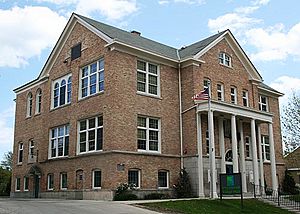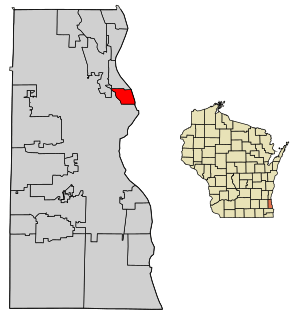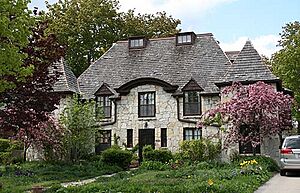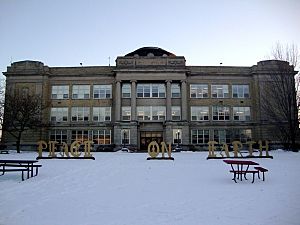Shorewood, Wisconsin facts for kids
Quick facts for kids
Shorewood, Wisconsin
|
|
|---|---|

|
|

Location of Shorewood in Milwaukee County, Wisconsin.
|
|
| Country | |
| State | |
| County | Milwaukee |
| Area | |
| • Total | 1.59 sq mi (4.12 km2) |
| • Land | 1.59 sq mi (4.12 km2) |
| • Water | 0.00 sq mi (0.00 km2) |
| Elevation | 679 ft (207 m) |
| Population
(2020)
|
|
| • Total | 13,859 |
| • Density | 8,716/sq mi (3,350/km2) |
| Time zone | UTC-6 (Central (CST)) |
| • Summer (DST) | UTC-5 (CDT) |
| Area code(s) | 414 |
| FIPS code | 55-73725 |
| GNIS feature ID | 1574071 |
Shorewood is a village located in Milwaukee County, Wisconsin, United States. It's a suburb of Milwaukee, meaning it's a smaller town right next to a big city. Shorewood is part of the larger Milwaukee metropolitan area. In 2020, about 13,859 people lived there.
Contents
History of Shorewood
In the early 1800s, before European settlers arrived, the Shorewood area was home to Native American tribes. These included the Menominee, Potawatomi, and Sauk people. The United States government acquired this land from the Menominee people in 1832 through a special agreement called the Treaty of Washington.
Early Settlements and Mills
The land became part of the Town of Milwaukee in 1835. When settlers came in the mid-1830s, they found a heavily forested area. They built two sawmills on the Milwaukee River's east bank. The small community around these mills was known as Mechanicsville. However, the mills didn't last long and closed during a financial crisis in 1837.
Thomas Bare, the first permanent white settler, arrived in 1841. He bought farmland east of the Milwaukee River. Around 1850, another community called Humboldt started in the area. Humboldt had industries like a paper mill and a grist mill, which grinds grain.
Growth and New Industries
Starting in the 1870s, the area's economy began to change. In 1873, the Northwestern Union Railway built train tracks through what is now Shorewood. These tracks ran along the Milwaukee River. The railroad helped local businesses, including the Milwaukee Cement Company. This company started digging for limestone near the river in 1876. The community that grew around this company was called Cementville. It thrived until the quarrying stopped in 1909.
Amusement Parks and Village Incorporation
In 1872, a resort called Lueddemann's-on-the-River opened in the southwestern part of Shorewood. People could reach it by riverboat and later by train. This resort was one of several fun places, like beer gardens and amusement parks, that operated in the area between 1872 and 1916.
One amusement park, Coney Island, opened in 1900 and caused some debate. It had loud music, bright electric lights, and a roller coaster. Some residents didn't like the noise and light pollution. They also disliked the rowdy visitors coming from Milwaukee on the new streetcar lines. Some blamed the Town of Milwaukee for allowing the park to operate and collecting fees from it.
Additionally, the roads in the community were not as good as those in Milwaukee. Residents were unhappy that their tax money, including from Coney Island, was being spread across the whole town instead of being used to improve their local area. Because of these issues, residents voted to become their own village. In August 1900, they officially became the Village of East Milwaukee, with about 300 people.

Developing as a Suburb
In the early 1900s, Shorewood grew into a "streetcar suburb" of Milwaukee. This meant public transportation, like streetcars, made it easy for people to travel to the city for work. The village's main area developed along the streetcar lines on Oakland Avenue and Atwater Road (now Capitol Drive). Wealthy Milwaukee residents also started building large homes along Lake Drive, overlooking Lake Michigan.
By 1913, the population grew to 1,255. In the 1910s, the village made improvements like paved roads, sidewalks, gas lines, and street signs. In 1917, the Village of East Milwaukee changed its name to the Village of Shorewood.
Growth in the 1920s and Beyond
Shorewood grew a lot in the 1920s. The population jumped from 2,650 in 1920 to 13,479 in 1930. During this time, up to 200 new homes were built each year. Famous architects like Alexander C. Eschweiler and Russell Barr Williamson designed many of these homes.
As the village grew, its local services became more organized. The health department started in 1918, the police department in 1920, and the fire department in 1929. In 1928, the village hired a full-time "village manager" to handle daily operations. Shorewood has used this type of government ever since. The school district also grew and was influenced by the ideas of philosopher John Dewey.
Shorewood's population was largest after World War II, with over 16,000 residents. Starting in the 1960s, the community began projects to update its areas. The population has slowly decreased to about 13,000 people as of 2010.
Geography
Shorewood is located at coordinates 43.092061 degrees North and -87.886333 degrees West.
The village is located between the Milwaukee River and Lake Michigan. It shares borders with the City of Milwaukee to the south and west. To the north, it borders Whitefish Bay. According to the United States Census Bureau, Shorewood covers about 1.59 square miles (4.12 square kilometers) of land, with no water area.
Shorewood's western border is at the edge of the Milwaukee River, not in the middle of the river like most towns. This is stated in the Village Charter.
Population Information
Shorewood's population has changed over the years:
- 1910: 707
- 1920: 2,650
- 1930: 13,479
- 1940: 15,184
- 1950: 16,199
- 1960: 15,990
- 1970: 15,576
- 1980: 14,327
- 1990: 14,116
- 2000: 13,763
- 2010: 13,162
- 2020: 13,859
2020 Census Details
In 2020, Shorewood had 13,859 people living in 6,681 households. The population density was about 8,716 people per square mile.
The racial makeup of the village was:
- 82.5% White
- 3.2% African American
- 0.2% Native American
- 6.0% Asian
- 6.5% from two or more races.
- 3.8% of the population was Hispanic or Latino (of any race).
About 47.8% of residents were male and 52.2% were female. Also, 20.2% of residents were under 18 years old, and 15.7% were 65 or older.
Education
The Shorewood School District has four public schools:
- Shorewood High School – for grades 9 through 12.
- Shorewood Intermediate School – for grades 7 and 8.
- Atwater Elementary School – for 4-year-old kindergarten through grade 6.
- Lake Bluff Elementary School – for 4-year-old kindergarten through grade 6.
The Archdiocese of Milwaukee also runs one Catholic school in Shorewood, St. Robert School, for kindergarten through grade 8.
Landmarks and Notable Buildings
Shorewood has several interesting places and buildings:
- Benjamin Church House – This Greek Revival style house was built in 1844. It was moved to Estabrook Park in Shorewood in 1938 to preserve it. It was added to the National Register of Historic Places in 1976.
- Estabrook Park – A large park covering almost 125 acres along the Milwaukee River. It has a pond, soccer fields, a dog park, and picnic areas.
- Hubbard Park – This wooded park, almost 5 acres, is also along the Milwaukee River. It has a long history, once being a resort and amusement park. It's home to the Hubbard Park Lodge, built in 1936.
- Shorewood High School campus – The school's 19-acre campus was built between 1924 and 1938. It has separate buildings for different subjects, and its auditorium was designed like the RKO Theater in New York City.
- Shorewood Village Hall – This building started as a four-room schoolhouse in 1908. The village bought it in 1916 to use as its village hall. It was updated in 1937 and again in 1985. It was added to the National Register of Historic Places in 1984.
- WITI TV Tower – Built in 1962, this tower was once one of the tallest free-standing towers in the world, standing 1,078 feet tall.
- Hayek Pharmacy – Located at 4001 N. Downer Ave, this was one of Shorewood's oldest retail buildings. It closed in 2018 after 100 years in business.
- The Ghost Train – This is an artistic experience at the Oak Leaf Trail Bridge and Capitol Drive. It first appeared on October 31, 2016.
- The Elizabeth Murphy House – Designed by famous architect Frank Lloyd Wright, this home was built in 1917–18. Its history was lost for a while but was rediscovered in 2015 and has since been restored.
Notable People from Shorewood
Many interesting people have lived in or are from Shorewood:
- Frankie Abernathy, a reality TV star.
- Les Aspin, who served in the U.S. House of Representatives and as U.S. Secretary of Defense.
- Kate Baldwin, a Broadway actress.
- Bill Carollo, an NFL referee.
- Dickey Chapelle, a photojournalist and the first female war correspondent.
- Katie Eder, an activist and social entrepreneur.
- John Fiedler, a voice actor known for being the voice of Piglet in Disney's Winnie the Pooh.
- Jerry Harrison, a keyboardist for the bands Talking Heads and The Modern Lovers.
- Walter Heller, an economic adviser to U.S. Presidents.
- Trixie Mattel, a drag queen, comedian, and businesswoman.
- Charlotte Rae, an actress known for The Facts of Life.
- William Rehnquist, a Chief Justice of the U.S. Supreme Court.
- Ben L. Salomon, a recipient of the Medal of Honor for World War II.
- Jim Sensenbrenner, a U.S. Representative.
- Leif Shiras, a professional tennis player.
- Judy Tyler, an actress.
- Jerry Zucker, David Zucker, and Jim Abrahams – co-directors of movies like Airplane! and Top Secret!. They grew up in Shorewood, and the fake national anthem in Top Secret! is actually the Shorewood High School fight song with funny lyrics!
See also
 In Spanish: Shorewood (Wisconsin) para niños
In Spanish: Shorewood (Wisconsin) para niños



